Apparent death
Apparent death, colloquially known as playing dead, feigning death, or playing possum, is a behavior in which animals take on the appearance of being dead. This form of animal deception is an adaptive behavior also known as tonic immobility or thanatosis. Apparent death can be used as a defense mechanism or as a form of aggressive mimicry, and occurs in a wide range of animals.
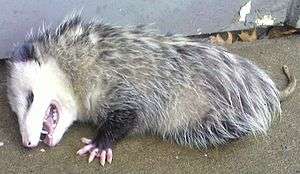
_playing_dead_(14178349634).jpg)
When induced by humans, the state is sometimes colloquially known as animal hypnosis. According to Gilman et al.,[1] the investigation of "animal hypnosis" dates back to the year 1646 in a report by Athanasius Kircher.
Tonic immobility
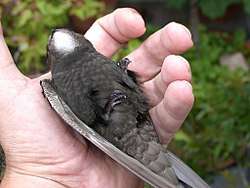
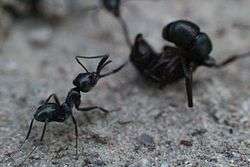
Tonic immobility (TI) is a behaviour in which some animals become apparently temporarily paralysed and unresponsive to external stimuli. In most cases this occurs in response to an extreme threat such as being captured by a (perceived) predator. However, in sharks exhibiting the behaviour, some scientists relate it to mating, arguing that biting by the male immobilizes the female and thus facilitates mating.[2]
Despite appearances, the animal remains conscious throughout tonic immobility.[3] Evidence for this includes the occasional responsive movement, scanning of the environment and animals in TI often taking advantage of escape opportunities.
In sharks
Some sharks can be induced into tonic immobility by inverting them and restraining them by hand, e.g. dogfish sharks, lemon sharks, whitetip reef sharks.[2][4][5][6] For tiger sharks (measuring 3–4 metres in length), tonic immobility can be induced by humans placing their hands lightly on the sides of the animal's snout in the area surrounding the eyes. During tonic immobility in sharks, the dorsal fins straighten, and both breathing and muscle contractions become more steady and relaxed. This state persists for an average of 15 minutes before recovery and the resumption of active behaviour. Scientists have exploited this response to study shark behaviour; chemical shark repellent has been studied to test its effectiveness and to more accurately estimate dose sizes, concentrations and time to recovery.[7] Tonic immobility can also be used as a form of mild anesthesia during experimental manipulations of sharks.[8][9]
Scientists also believe that tonic immobility can be a stressful experience for sharks. By measuring blood chemistry samples when the shark is immobile, it has been suggested that tonic immobility can actually put stress on the shark, and reduce breathing efficiency. However, it has also been proposed that sharks have a series of compensatory mechanisms that work to increase respiration rates and lower stress.[10]
It has been observed that orcas can exploit sharks' tonic immobility to prey on large sharks. Some orcas ram sharks from the side to stun them, then flip the sharks to induce tonic immobility and keep them in such state for sustained time. For some sharks, this prevents water from flowing through their gills and the result can be fatal.[11]
In teleost fishes
Goldfish, trout, rudd, tench, brown bullhead, medaka, paradise fish, and topminnow have been reported to go limp when they are restrained on their backs.[12] Oscars seem to go into shock when they are stressed (when their aquarium is being cleaned, for example): they lie on their side, stop moving their fins, start to breathe more slowly and deeply, and lose colour.[13] A similar behavior has been reported for convict tangs in the field.[14]
In reptiles
Tonic immobility can be reliably induced in iguanas by a combination of inversion, restraint and moderate pressure. During TI, there are obvious changes in respiration including a decline in respiration rate, the rhythm becomes sporadic, and the magnitude irregular. The prolonged period of TI does not seem to be consistent with the fear hypothesis, but could be the result of a period of cortical depression due to increased brain stem activity.[15]
Tonic immobility can also be induced in the Carolina anole. The characteristics of this TI vary as a function of the duration and condition of captivity.[16]
In rabbits
In 2006, a single study in rabbits tried to find a link between a fear-motivated stress state and some of the physiological responses induced by tonic immobility. Researchers observed an increase in heart rate and breathing immediately following periods of tonic immobility, and while these comprise an expected physiologic reaction to sudden position change,[17] the data were nonetheless used to advance a conclusion that despite the appearance of deep relaxation, the rabbits are actually in fear for their lives.[18] While the study failed to explore why rabbits seem to enjoy self-induction of tonic immobility and are sometimes found sleeping on their backs, it is now routinely cited to support a notion that rabbits actually hate what they appear to enjoy. The researchers did allow for induction of tonic immobility in rabbits as appropriate for certain veterinary procedures, as it holds less risk than anesthesia.[18]
In chickens
See Chicken hypnotism.
In ducks
Tonic immobility has been viewed in some duck species.[19]
In humans
Tonic immobility has been hypothesized to occur in humans undergoing intense trauma, including sexual assault.[20][21][22]
There is also an increasing body of evidence that points to a positive contribution of tonic immobility in human functioning. Thus, defensive immobilization is hypothesized to have played a crucial role in the evolution of human parent-child attachment,[23] sustained attention and suggestibility,[24][25] REM sleep[26] and theory of mind.[27]
As a scientific tool
Tonic immobility is considered to be a fear-potentiated response induced by physical restraint and characterised by reduced responsiveness to external stimulation. It has been used as a measure in the assessment of animal welfare, particularly hens, since 1970.[28][29][30] The rationale for the TI test is that the experimenter simulates a predator thereby eliciting the anti-predator response. The precept is that the prey animal 'pretends' to be dead to be able to escape when/if the predator relaxes its concentration. Death-feigning birds often take advantage of escape opportunities; TI in quail reduces the probability of the birds being predated by cats.[31]
To induce tonic immobility, the animal is gently restrained on its side or back for a period of time, e.g. 15 seconds. This is done either on a firm, flat surface or sometimes in a purpose-built ‘V’- or ‘U’-shaped restraining cradle. In rodents, the response is sometimes induced by additionally pinching or attaching a clamp to the skin at the nape of the neck.[32] Scientists record behaviours such as the number of inductions (15-second restraining periods) required for the animal to remain still, the latency to the first major movements (often cycling motions of the legs), latency to first head or eye movements and the duration of immobility, sometimes called the ‘righting time’.
Tonic immobility has been used to show that hens in cages are more fearful than those in pens,[30] hens on the top tier of tiered battery cages are more fearful than those on the lower levels,[33] hens carried by hand are more fearful than hens carried on a mechanical conveyor,[34] and hens undergoing longer transportation times are more fearful than those undergoing transport of a shorter duration.[35]
Tonic immobility as a scientific tool has also been used with mice,[36] gerbils,[37] guinea pigs,[38] rats,[32] rabbits[39] and pigs.[40]
Thanatosis
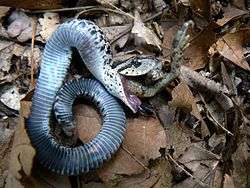
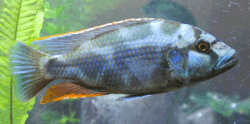
In animal behaviour, thanatosis (from the Greek noun θανάτωσις, meaning "putting to death"; cf. : Thanatos) is the process by which an animal feigns death in order to evade unwelcome attention. It can be for various reasons, such as that of a prey evading a predator, a male trying to mate with a female, or a predator trying to lure potential prey closer. The French biologist Georges Pasteur classifies it as a form of self-mimesis, a form of camouflage or mimicry in which the "mimic" imitates itself in a dead state.[41]
For defense
For defensive purposes, thanatosis hinges on the pursuer's becoming unresponsive to its victim, as most predators only catch live prey.[41]
In beetles, artificial selection experiments have shown that there is heritable variation for length of death-feigning. Those selected for longer death-feigning durations are at a selective advantage to those at shorter durations when a predator is introduced,[42] which suggests that thanatosis is indeed adaptive.
In the hog-nosed snake, a threatened individual rolls onto its back and appears to be dead when threatened by a predator, while a foul-smelling, volatile fluid oozes from its body. Predators, such as cats, then lose interest in the snake, which both looks and smells dead. One reason for their loss of interest is that rotten-smelling animals are avoided as a precaution against infectious disease, so the snake is, in this case, exploiting that reaction. Newly hatched young also instinctively show this behaviour when rats try to eat them.[43]
In mammals, the Virginia opossum is perhaps the best known example of defensive thanatosis. "Playing possum" is an idiomatic phrase which means "pretending to be dead".[44] It comes from a characteristic of the Virginia opossum, which is famous for pretending to be dead when threatened.[45][46] This instinct does not always pay off in the modern world; for example, opossums scavenging roadkill may use it in response to the threat posed by oncoming traffic, and subsequently end up as roadkill themselves.[47]
The usual advice for humans attempting to survive an attack by a brown bear is to lie face down, cover the face with one’s hands/arms/elbows, and 'play dead'; hopefully the bear will get bored and wander away after a while.[48]
"Playing possum" can also mean simply pretending to be injured, unconscious, asleep, or otherwise vulnerable, often to lure an opponent into a vulnerable position him or herself.[44]
Thanatosis has also been observed in some invertebrates such as the wasp Nasonia vitripennis,[49] and the cricket, Gryllus bimaculatus.[50]
For reproduction
In the spider species Pisaura mirabilis, male spiders often stage elaborate rituals of gift-giving and thanatosis to avoid getting eaten by female spiders during mating. Studies have shown higher chances of success in mating with females for males who exhibit death-feigning more frequently than for males who do it less.[51]
For predation
Nimbochromis (sleeper cichlids), endemic to Lake Malawi in East Africa, are large predatory fish for whom thanatosis is a form of aggressive mimicry. This fish will lie down on its side on the bottom sediments and assume a blotchy coloration. Scavengers, attracted to what seems like a dead fish, will approach the predator to investigate. N. livingstoni then abandons the pretense, righting itself again and quickly eating any scavenger unfortunate enough to come too close.[52][53] A similar strategy has also been observed in the African cichlid Lamprologus lemairii from Lake Tanganyika [54] and in the Central American yellowjacket cichlid Parachromis friedrichsthalii.[55]
See also
- Aggressive mimicry
- Anti-predator adaptation
- Autohaemorrhaging – animals deliberately ejecting haemolymph or blood from their bodies
- Chicken hypnotism
- Fight-or-flight response
- REM sleep – stage in the human sleep cycle
- Syncope (medicine) – transient loss of consciousness
- Tetrodotoxin – neurotoxin which inhibits the flow of sodium into cells causing paralysis of muscles
- Trout tickling
- Vasovagal response
References
- Gilman, T.T.; Marcuse, F.L.; Moore, A.U. (1960). "Animal hypnosis: a study of the induction of tonic immobility in chickens". Journal of Comparative Physiology and Psychology. 43 (2): 99–111. doi:10.1037/h0053659. PMID 15415476.
- Henningsen, A.D. (1994). "Tonic immobility in 12 elasmobranchs - use as an aid in captive husbandry". Zoo Biology. 13 (4): 325–332. doi:10.1002/zoo.1430130406.
- Jones, R.B (1986). "The tonic immobility reaction of the domestic fowl: a review". World's Poultry Science Journal. 42 (1): 82–96. doi:10.1079/WPS19860008.
- Whitman, P.A.; Marshall, J.A.; Keller, E.C.Jr (1986). "Tonic immobility in the smooth dogfish shark, Mustelus canis (Pisces, Carcharhinidae)". Copeia. 1986 (3): 829–832. doi:10.2307/1444973. JSTOR 1444973.
- Watsky, M.A.; Gruber, S.H. (1990). "Induction and duration of tonic immobility in the lemon shark, Negaprion brevirostris". Fish Physiology and Biochemistry. 8 (3): 207–210. doi:10.1007/bf00004459. PMID 24221983.
- Davie, P.S.; Franklin, C.E.; Grigg, G.C. (1993). "Blood pressure and heart rate during tonic immobility in the black tipped reef shark, Carcharhinus melanoptera". Fish Physiology and Biochemistry. 12 (2): 95–100. doi:10.1007/bf00004374. PMID 24202688.
- "Tonic immobility". Shark defense: Chemical repellents. Archived from the original on June 14, 2006. Retrieved January 28, 2006.
- Heithaus, M.R.; Dill, L.M.; Marshall, G.J.; Buhleier, B. (2002). "Habitat use and foraging behavior of tiger sharks (Galeocerdo cuvier) in a seagrass ecosystem". Marine Biology. 140 (2): 237–248. doi:10.1007/s00227-001-0711-7.
- Holland, K.N.; Wetherbee, B.M.; Lowe, C.G.; Meyer, C.G. (1999). "Movements of tiger sharks (Galeocerdo cuvier) in coastal Hawaiian waters". Marine Biology. 134 (4): 665–673. doi:10.1007/s002270050582.
- Brooks, E. J., et al. "The Stress Physiology of Extended Duration Tonic Immobility in the Juvenile Lemon Shark, Negaprion Brevirostris (Poey 1868)." Journal of experimental marine biology and ecology 409.1-2 (2011): 351-60.
- Lauren Smith (2017-11-16). "Orcas vs great white sharks: in a battle of the apex predators who wins?". The Guardian. Retrieved 2017-11-18.
- Table; Whitman, P.A.; Marshall, J.A.; Keller, E.C.Jr (1986). "Tonic immobility in the smooth dogfish shark, Mustelus canis (Pisces, Carcharhinidae)". Copeia. 1986 (3): 829–832. doi:10.2307/1444973. JSTOR 1444973.
- Crawford, F.T. (1977). "Induction and duration of tonic immobility". The Psychological Record. 27: 89–107. doi:10.1007/bf03394435.
- Howe, J.C. (1991). "Field observations of death feigning in the convict tang, Acanthurus triostegus (Linnaeus), with comments on the nocturnal color pattern in juvenile specimens". Journal of Aquariculture and Aquatic Sciences. 6: 13–15.
- Prestrude, A.M.; Crawford, F.T. (1970). "Tonic immobility in the lizard, iguana iguana". Animal Behaviour. 18 (2): 391–395. doi:10.1016/s0003-3472(70)80052-5.
- Hennig, C.W; Dunlap, W.P. (1978). "Tonic immobility in Anolis carolinensis: Effects of time and conditions of captivity". Behavioral Biology. 23 (1): 75–86. doi:10.1016/s0091-6773(78)91180-x.
- Cotsamire, DL; et al. (1987). "Position as a Variable for Cardiovascular responses during exercise". Clinical Cardiology. 10 (3): 137–142. doi:10.1002/clc.4960100302. PMID 3829483.
- McBride, Anne; et al. (2006). "Trancing rabbits: Relaxed hypnosis or a state of fear?". Proceedings of the VDWE International Congress on Companion Animal Behaviour and Welfare: 135–137. Retrieved September 2, 2013. (downloadable .doc file). • Click here Archived 2010-11-24 at the Wayback Machine for PDF copy from hopperhome.com.
- https://www.nationalgeographic.com/news/2013/10/animals-play-dead-sharks-snakes
- http://www.aic.gov.au/media_library/publications/proceedings/20/galliano.pdf
- Why many rape victims don’t fight or yell
- Kalaf, Juliana; Coutinho, Evandro Silva Freire; Vilete, Liliane Maria Pereira; Luz, Mariana Pires; Berger, William; Mendlowicz, Mauro; Volchan, Eliane; Andreoli, Sergio Baxter; Quintana, Maria Inês; De Jesus Mari, Jair; Figueira, Ivan (March 7, 2017). "Sexual trauma is more strongly associated with tonic immobility than other types of trauma – A population based study". Journal of Affective Disorders. 215: 71–76. doi:10.1016/j.jad.2017.03.009. PMID 28319694.
- Porges S W (2003). "Social engagement and attachment: a phylogenetic perspective". Annals of the New York Academy of Sciences. 1008 (1): 31–47. Bibcode:2003NYASA1008...31P. doi:10.1196/annals.1301.004. PMID 14998870.
- Hoskovec, J; Svorad, D (1969). "The relationship between human and animal hypnosis". American Journal of Clinical Hypnosis. 11 (3): 180–182. doi:10.1080/00029157.1969.10402029. PMID 5764620.
- Cortez, C. M.; Silva, D (2013). "Hypnosis, tonic immobility and electroencephalogram". Jornal Brasileiro de Psiquiatria. 62 (4): 285–296. doi:10.1590/S0047-20852013000400006. ISSN 0047-2085.
- Tsoukalas I (2012). "The origin of REM sleep: A hypothesis". Dreaming. 22 (4): 253–283. doi:10.1037/a0030790.
- Tsoukalas, Ioannis (2018). "Theory of Mind: Towards an Evolutionary Theory". Evolutionary Psychological Science. 4 (1): 38–66. doi:10.1007/s40806-017-0112-x.Pdf.
- Gallup, G.G. Jr.; Nash, R.F.; Potter, R.J.; Donegan, N.H. (1970). "Effect of varying conditions of fear on immobility reactions in domestic chickens (Gallus gullus)". Journal of Comparative and Physiological Psychology. 73 (3): 442–445. doi:10.1037/h0030227. PMID 5514679.
- Gallup, G.G. Jr (1979). "Tonic immobility as a measure of fear in the domestic fowl". Animal Behaviour. 27: 316–317. doi:10.1016/0003-3472(79)90159-3.
- Jones, B.; Faure, J.M. (1981). "Tonic immobility ("righting time") in laying hens housed in cages and pens". Applied Animal Ethology. 7 (4): 369–372. doi:10.1016/0304-3762(81)90063-8.
- Forkman, B.; Boissy, A.; Meunier-Salaün, M.-C. Canali; Jones, R.B. (2007). "A critical review of fear tests used on cattle, pigs, sheep, poultry and horses". Physiology & Behavior. 92 (3): 340–374. doi:10.1016/j.physbeh.2007.03.016. PMID 18046784.
- Zamudio, S.R.; Quevedo-Corona, L.; Garcés, L.; De La Cruz, F. (2009). "The effects of acute stress and acute corticosterone administration on the immobility response in rats". Brain Research Bulletin. 80 (6): 331–336. doi:10.1016/j.brainresbull.2009.09.005. PMID 19772903.
- Jones, R.B. (1987). "Fearfulness of caged laying hens: The effects of cage level and type of roofing". Applied Animal Behaviour Science. 17 (1–2): 171–175. doi:10.1016/0168-1591(87)90018-9.
- Scott, G.B.; Moran, P. (1993). "Fear levels in laying hens carried by hand and by mechanical conveyors". Applied Animal Behaviour Science. 36 (4): 337–345. doi:10.1016/0168-1591(93)90131-8.
- Cashman, P.; Nicol, C.J.; Jones, R.B. (1989). "Effects of transportation on the tonic immobility fear reactions of broilers". British Poultry Science. 30 (2): 211–221. doi:10.1080/00071668908417141.
- Bazovkina, D.V.; Tibeikina, M.A.; Kulikov, A.V.; Popova, N.K. (2011). "Effects of lipopolysaccharide and interleukin-6 on cataleptic immobility and locomotor activity in mice". Neuroscience Letters. 487 (3): 302–304. doi:10.1016/j.neulet.2010.10.043. PMID 20974218.
- Griebel, G.; Stemmelin, J.; Scatton, B. (2005). "Effects of the cannabinoid CB1 receptor antagonist rimonabant in models of emotional reactivity in rodents". Biological Psychiatry. 57 (3): 261–267. doi:10.1016/j.biopsych.2004.10.032. PMID 15691527.
- Donatti, A.F.; Leite-Panissi, C.R.A. (2011). "Activation of corticotropin-releasing factor receptors from the basolateral or central amygdala increases the tonic immobility response in guinea pigs: An innate fear behaviour". Behavioural Brain Research. 225: 23–30. doi:10.1016/j.bbr.2011.06.027. PMID 21741994.
- Verwer, C.M.; van Amerongen, G.; van den Bos, R.; Coenraad, F.M.H. (2009). "Handling effects on body weight and behaviour of group-housed male rabbits in a laboratory setting". Applied Animal Behaviour Science. 117 (1–2): 93–102. doi:10.1016/j.applanim.2008.12.004.
- Hessing, M.J.C.; Hagelsø, A.M.; Schouten, W.G.P.; Wiepkema, P.R.; van Beek, J.A.M. (1994). "Individual behavioral and physiological strategies in pigs". Physiology and Behavior. 55 (1): 39–46. doi:10.1016/0031-9384(94)90007-8. PMID 8140172.
- Pasteur, G (1982). "A classificatory review of mimicry systems". Annual Review of Ecology and Systematics. 13: 169–199. doi:10.1146/annurev.es.13.110182.001125.
- Miyatake, T; Katayama, K.; Takeda, Y.; Nakashima, A.; Mizumoto, M.; Mizumoto, M (2004). "Is death-feigning adaptive? Heritable variation in fitness difference of death-feigning behaviour". Proceedings of the Royal Society B. 271 (1554): 2293–2296. doi:10.1098/rspb.2004.2858. PMC 1691851. PMID 15539355.
- Triumph of Life (2006). Alexandria, VA: PBS Home Video.
- The Chambers Dictionary. Allied Publishers. 1998. p. 1279. ISBN 978-81-86062-25-8.
- Francq, E. (1969). "Behavioural aspects of feigned death in the opossum Didelphis marsupialis". American Midland Naturalist. 81 (2): 556–568. doi:10.2307/2423988. JSTOR 2423988.
- Ann Bailey Dunn. "Playing Possum". Wonderful West Virginia. Archived from the original on October 1, 2011. Retrieved May 11, 2011.
- "Virginia Opossum". Mass Audubon. Retrieved May 11, 2011.
Opossums are frequently encountered as corpses along highways. Some biologists believe that many die as they feed on road-killed animals – a favorite food. Others believe that the opossums’ small brain (5 times smaller than that of a raccoon) suggests that they may just be too dumb to get out of the way of vehicles!
- "How to survive a bear attack".
- King, B.; H. Leaich (2006). "Variation in propensity to exhibit thanatosis in Nasonia vitripennis (Hymenoptera: Pteromalidae)". Journal of Insect Behaviour. 19 (2): 241–249. CiteSeerX 10.1.1.581.3100. doi:10.1007/s10905-006-9022-7.
- Nishino, H. (2004). "Motor output characterizing thanatosis in the cricket Gryllus bimaculatus". Journal of Experimental Biology. 207 (22): 3899–3915. doi:10.1242/jeb.01220. PMID 15472021.
- Line Spinner Hansen; Sofia Fernandez Gonzales; Søren Toft; Trine Bilde (2008). "Thanatosis as an adaptive male mating strategy in the nuptial gift–giving spider Pisaura mirabilis". Behavioral Ecology. 19 (3): 546–551. doi:10.1093/beheco/arm165. Retrieved May 11, 2011.
- Gene S. Helfman; Bruce B. Collette; Douglas E. Facey (1997). The diversity of fishes. Wiley-Blackwell. p. 324. ISBN 978-0-86542-256-8.
- McKaye, K.R. (1981). "Field observation on death feigning: a unique hunting behavior by the predatory cichlid, Haplochromis livingstonii, of Lake Malawi". Environmental Biology of Fishes. 6 (3–4): 361–365. doi:10.1007/bf00005766.
- Lucanus, O (1998). "Darwin's pond: Malawi and Tanganyika". Tropical Fish Hobbyist. 47: 150–154.
- Tobler, M (2005). "Feigning death in the Central American cichlid Parachromis friedrichsthalii". Journal of Fish Biology. 66 (3): 877–881. doi:10.1111/j.0022-1112.2005.00648.x.
| Look up play possum in Wiktionary, the free dictionary. |
| Wikimedia Commons has media related to Apparent death. |